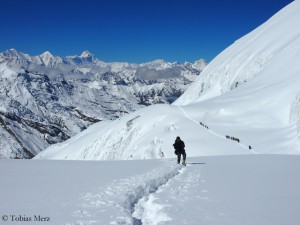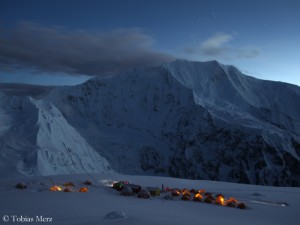HACE, the hidden danger
20 doctors, nearly twice as many test persons. The Swiss research expedition to the seven-thousander Himlung Himal in fall 2013 had the objective to investigate the effects of high altitude on the human body. More than two years later, the first results are there to see. I have talked about it to Dr. Tobias Merz. The 46-year-old is a senior physician at the Department of Intensive Care Medicine at the University Hospital in Bern. Since his youth, Merz has been doing sports in the mountains. So it’s no coincidence that he has committed himself to high altitude medicine too. “In intensive care medicin a disease takes organ systems to the limits of the possible, in high-altitude medicine external conditions are responsible for this,” says Merz. Before going on expedition to Himlang Himal, he had already experienced high altitude as a climber in the Andes and the Himalayas. On the eight-thousander Shishapangma, Merz had reached a height of about 7,600 meters. He then had had to give up his own summit ambitions because he had been needed for a rescue. On Himlung Himal, he stood on the highest point.
Dr. Merz, in 2013 you reached the 7,126 meter-high summit of Himlung Himal. Do you feel somewhat queasy in hindsight if you look at your first research findings?
I already knew that high altitude climbing is a high-risk sport and that it takes you to limits of physiology and rationality. For me, the results were more a confirmation of what I had suspected and less a huge surprise.
But you have worked out something worrying for high altitude mountaineers.
We actually had two important results. One is very reassuring, one very worrying.
Let’s start with the bad news.
There were 38 probands who were climbing this mountain. 15 of them reached an altitude of more than 7,000 meters. We have found evidence that three of these people suffered from cerebral edema while climbing, means that liquid had leaked from the blood vessels into the brain tissue. In that case the brain is swelling what can turn into a life threatening situation. It was worrying that neither we as doctors nor the test persons had noticed these cerebral edemas. Actually, the classical doctrine is that there a clinical symptoms occurring in parallel to the development of a cerebral edema such as headache, nausea or general sickness and that one has still time to take action, that is first and foremost descending quickly in order to avoid a life-threatening complication. But obviously it is not like that. We think that a cerebral edema can occur without warning. Of course, it makes the situation far more critical if a clinical disaster can happen like out of nowhere, within minutes.
But it was micro bleedings that were not even perceived by the mountaineers.
Correct. On top of the mountain these people felt like those who had no micro-hemorrhages. But these micro-bleedings that we could detect afterwards at the test persons are evidence of significant cerebral edema at high altitude. The good news is that these micro-bleedings can not be equated with brain damage. These climbers have returned and now have a completely normal brain. You can still see a few leaked blood cells, but the brain tissue is unharmed. So the climbers had a narrow escape. They were close to developing a severe cerebral edema. It then requires only a little increase in volume to fall from a normal level of consciousness into a coma.
So there are no warnings. But can we even say at which altitude the risk of cerebral edema increases dramatically?
We cannot prove it due to the design of our study. We did the MRIs (Magnetic resonance imaging) before and after the expedition. The micro-bleedings occurred sometime in between. But we found it only at test persons who were higher than 7,000 meters. This is no proof, but at least an indication. And the affected climbers were those among all who had the lowest oxygen level. During the expedition, we checked the oxygen saturation in arterial blood twice a day.
Is there perhaps a predisposition to High Altitude Cerebral Edema (HACE)? And if yes, is it possible to test this vulnerability in advance?
No, such tests do not exist. We only can say very pragmatically: A person who had already a cerebral edema at 4,000 meters is more likely vulnerable in ever higher altitude than someone who has never had a cerebral edema. But there are no studies on that.
But younger people are probably more vulnerable than older ones. This has more mechanical reasons. The brain volume decreases with age, that is, a 65-year-old has significantly less brain matter in his skull than a young person. If the somewhat shrunken brain begins to swell, it simply has more space than the brain of a 20-year-old, whose skull is actually mostly filled with brain matter.
Would you say in the light of your study that high altitude climbing is irresponsible from a medical perspective?
I would rather say that every climber must consider by himself how much risk he wants to take. He has to be aware that a certain percentage of climbers get a cerebral edema. As in all high risk sports, it’s an individual decision whether one is willing to accept the danger.
You can book an expedition to the mountain we climbed from catalog, paying about 12,000 to 14,000 Euros. We as clients assume that the product which we buy is safe. And we also tend to delegate the responsibility for our well-being to the operator, expedition leader or guide. But it does not work. Actually, any high altitude mountaineer must be aware that he personally has to take this risk and nobody can take over that responsibility from him. This awareness is lacking a bit in commercial high-altitude mountaineering.
Also an expedition doctor, if there is one, can do little.
The chance that he is getting sick is the same as for all others. And he can do little to treat the high altitude cerebral edema. It’s even difficult to bring down an ill climber from 7,000 meters. And it has to happen quickly. This brings an expedition very quickly to the verge of its logistical facilities.
Finally once again the good news: The statement that high altitude mountaineering makes stupid belongs to the category of popular misconceptions, doesn’t it?
Yes. For methodological reasons, we had doubts concerning the results of previous studies saying that climbing at higher altitudes, starting already at the height of Mont Blanc, cause brain damage. In these studies usually mountaineers were compared with non-climbers. But if I compare a 45-year-old mountaineer with a 20-year-old medical student, I will always find a relevant difference. That’s why we conducted this study, in which we examined every mountaineer with MRI before and after the expedition. We could neither prove that there is a loss of brain matter, nor that micro-infarctions occur as described in previous studies. Even the three climbers in our group who had micro-hemorrhages suffered no permanent brain damage. The cerebral edema is gone.











